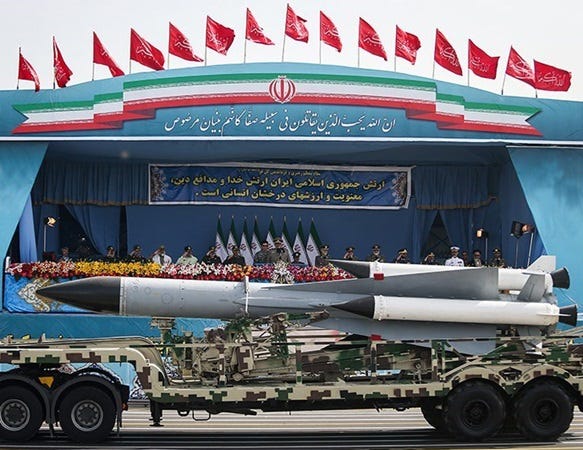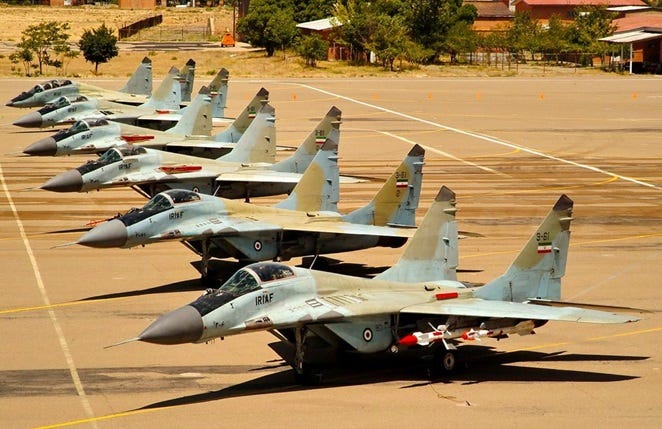Thinking About the Unthinkable
And concluding that we can't afford to let Iran step over the nuclear threshold
Iran’s abortive missile blitz against Israel may have been something of an embarrassment for the ayatollahs, but it compelled a disturbing question: What might happen if Iran steps across the nuclear threshold? No doubt, that prospect keeps members of the Israeli government and the IDF awake at night. But scant attention has been paid to the follow-up questions. For example, what might be the size and sophistication of an Iranian nuclear arsenal? In military terms, how much of a threat would it pose to Israel? And how would it change the strategic calculus of the Middle East?
To take the last question first, possession of nuclear weapons would obviously strengthen Iran’s overall position in the region. Neighboring states might think twice about signing on to an informal anti-Iranian coalition, led by the United States and including Israel. And a nuclear-armed Iran would be less worried about retaliation for its terroristic misbehavior. The prestige accruing to the regime by its possession of nuclear weapons might even tamp down internal dissent. All this seems self-evident.
The other two questions are not so easily answered.
Concerning the size and capability of a hypothetical Iranian nuclear force, it should first be noted that initially, at least, it would consist of fission rather than fusion weapons. US fission weapons in service before the introduction of fusion weapons ranged in yield from sub-kiloton to 160 kilotons; yields in the range of 25-50 kilotons seem likely for possible Iranian fission weapons.
Another point to bear in mind is that there’s a difference between a device capable of producing an explosion via a fission reaction, and a weapon that can be mated to a delivery system. During World War Two, the United States developed two types of fission bombs in tandem with an aircraft capable of delivering them: the Boeing B-29 Superfortress. Though this aircraft was not originally conceived as an atomic bomber, it had the range and load-carrying capability to serve as such with relatively minor modifications. The two atomic bombs that were developed, Little Boy (uranium) and Fat Man (plutonium) were therefore sized for the B-29.
For Iran, there are three possible nuclear delivery systems: manned aircraft, cruise missiles, and ballistic missiles. From a design standpoint, the easiest option would be a fission bomb sized for delivery by aircraft. For example, the US Mark 7 fission bomb (in service 1952-67) weighed in at 1,600lb and had a maximum explosive yield of up to 60 kilotons. A fission bomb of this size could be carried by several aircraft in the inventory of the Iranian Air Force, including the Russian-built Mikoyan MiG-29 strike fighter, though it would require modifications. It seems unlikely, however, that they could penetrate Israel’s air defenses, and though nuclear-capable aircraft would pose a threat not to be disregarded, they’re the least reliable delivery system.
That leaves missiles, ballistic and cruise. The design challenge presented here involves size. As an example, the US W85 fusion warhead for the Pershing II medium-range ballistic missile (MRBM) weighed in at 591lb, with a maximum explosive yield of 80 kilotons. Iran has a solid-fuel MRBM in service, the Sejji, which is roughly comparable to the Pershing II as regards range, with a warhead payload of about 1,000lb. It may therefore be assumed that the Sejji could carry a fission warhead about one and a half times the size of the W85 and with a comparable yield.
To appreciate the design challenges involved, it helps to understand what goes on inside a nuclear weapon when detonation commences. There are two types of fission devices: the gun type in which a high explosive charge hurls one mass of fissionable material against another, initiating the chain reaction; and the implosion type in which a hollow sphere of high explosives compresses a mass of fissionable material at its center, initiating the chain reaction. For a bomb, either type will serve; for a missile warhead, the implosion type is preferred.
“The Effects of a Nuclear Attack on the Reo Grande Valley” on Robert Johnston’s Johnston’s Archive website includes a detailed description of the implosion type, using a Soviet-era thermonuclear missile warhead as an example. Here, it suffices to say that the process is rather more complicated than lighting the fuse of a firecracker or pulling the pin of a hand grenade.
Assuming that Iran could successfully weaponize a fission device to produce bombs and missile warheads, there remains the question of their reliability, accuracy, and vulnerability to defense countermeasures. There are reasons to think that Iranian nuclear weapons and delivery systems would not perform particularly well. But even three or four nuclear hits would be extremely bad news for a country of Israel’s size.
Israel has the best air force and the best ground-based air defenses in the Middle East, and it seems probable that an Iranian nuclear strike by aircraft would not succeed. Even in the worst case, if one or two planes got through and delivered their bombs, Iran would then be subject to massive retaliation. Though Israel has never officially confirmed that it possesses nuclear weapons, estimates of the country’s stockpile range from two hundred to four hundred bombs and warheads, deployed with aircraft, on ballistic missiles, and aboard submarines. These or some of them would surely be unleashed on Iran.
The same reasoning applies to a large Iranian attack with conventional ballistic missiles and cruise missiles masking the nuclear missiles. On its face, such an attack would seem to have better prospects for success. Faced with a big missile barrage, the Israelis would have less time to react, and their defenses might be saturated. But even if this tactic enables several nuclear missiles to reach their targets, suppression of Israel’s retaliatory forces could not be guaranteed and again, massive retaliation would follow.

Finally, it’s all but certain that a successful or partially successful Iranian nuclear strike on Israel would cause a great deal of collateral damage, both immediately and in the long term. Tens to hundreds of thousands of Palestinian Arabs in Israel, the West Bank and Gaza would surely be killed or injured. Neighboring countries—Egypt, Jordan, Syria, Lebanon, possibly even Iraq and Saudi Arabia—would suffer from the fallout, both literal and metaphorical. The entire region would be thrown into chaos—a humanitarian disaster without precedent in modern history. Even if the Iranian regime somehow survived Israeli retaliation, it wouldn’t be long for this world after provoking a disastrous nuclear war.
It therefore seems unlikely that Iran’s acquisition of nuclear weapons would lead inevitably to war. But the regime would certainly be emboldened by its entry into the nuclear club. Its foreign policy would become more assertive, its sponsorship of regional and global terrorism more blatant. And of course, a nuclear-armed Iran would make every Middle East crisis more dangerous for the region and the world, raising the possibility that a miscalculation on one side or the other might end in catastrophe.
These are reasons enough to make sure that the ayatollahs never, ever get their hands on the Bomb.






Israel has a second strike capability with its nuclear capable Dolphin Class submarines. A nuclear strike on Israel would almost certainly result in a massive nuclear attack on Iran.
I think the biggest risk of an Iranian nuclear weapon is the impact it would have on other nations in the region. A nuclear armed Iran would surely inspire Saudi Arabia, Turkey and perhaps Egypt to at a least attempt to acquire their own nuclear arsenals. Pakistan will be happy to provide nuclear weapons to Saudi Arabia (for a price). Turkey has the ability to develop and produce its own.
A nuclear armed Middle East, all thanks to Obama and Biden. Their horrific legacy will be cursing us for decades.
Nice piece, as always.
The crux of the argument is in the piece's penultimate paragraph:
"It therefore seems unlikely that Iran’s acquisition of nuclear weapons would lead inevitably to war. But the regime would certainly be emboldened by its entry into the nuclear club. Its foreign policy would become more assertive, its sponsorship of regional and global terrorism more blatant. And of course, a nuclear-armed Iran would make every Middle East crisis more dangerous for the region and the world, raising the possibility that a miscalculation on one side or the other might end in catastrophe".
You could replace "Iran" in the penultimate paragraph above for "USA", "USSR", "Israel", or any actor, and could then note the consequences of "emboldened ... more assertive ... sponsorship ... crisis more dangerous ... miscalculation ... end in catastrophe", don't you think?
And couldn't you also come to the same conclusion in the final paragraph following?
"These are reasons enough to make sure that the <enter your chosen bad guy's name here> never, ever get their hands on the Bomb".